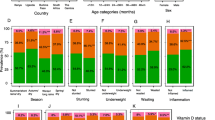Abstract
Vitamin D deficiency is common in newly resettled refugee children and is associated with significant morbidity including rickets. To determine risk factors and burden of vitamin D deficiency in newly resettled refugee children in Australia. A descriptive epidemiological study and survey on refugee children attending an outpatient general health clinic at the Children’s Hospital Westmead, Sydney. 215 patients were examined (age range 0–17 years), (76%) majority were from Africa. Mean serum 25OHD level was 46 nmol/L (SD = 24) (sufficiency range 50–150 nmol/L). 40% had mild deficiency (26–50 nmol/L), 19% moderate deficiency (13–25 nmol/L) and 2% were severely deficient (<13 nmol/L). Deficiency was most common in East African (72%) and Middle Eastern (66%) refugees, children in early puberty (89%) and those living in Australia >6 months (71%). Deficient children were more likely to have had movement restrictions and longer time in hiding in their country of refuge (OR 3:1[CI 0.9–9.7], P = .062).

Similar content being viewed by others
References
Dunn PM. Francis Glisson and the “discovery” of rickets. Arch Dis Child Fetal Neonatal Ed. 1998;78(2):F154–5.
Rosen G. A history of public health. Expanded ed. Baltimore: The John Hopkins University Press; 1993.
Holick MF. Resurrection of vitamin D deficiency and rickets. J Clin Invest. 2006;116(8):2062–72.
Munns C, Zacharin M, Rodda C, Batch J, Morley R, Cranswick N. Prevention and treatment of infant and childhood vitamin D deficiency in Australia and New Zealand: a consensus statement. Med J Aust. 2006;185(5):268–72.
Holick MF. Evolution, biologic functions, and recommended dietary allowances for vitamin D. In: Holick MF, editor. Vitamin D: physiology, molecular biology and clinical applications. New Jersey: Humana Press; 1999.
Grover S, Morley R. Vitamin D deficiency in veiled or dark-skinned pregnant women. Med J Aust. 2001;175:251–2.
Lips P, Hosking D, Lippuner K, Norquist JM, Wehren L, Maalouf G, et al. The prevalence of vitamin D inadequacy amongst women with osteoporosis: an international epidemiological investigation. J Intern Med. 2006;260(3):245–54.
Nozza J, Rodda C. Vitamin D deficiency in mothers of infants with rickets. Med J Aust. 2001;175:253–5.
Garland FC, Garland CF, Gorham ED, Young JF. Geographic variation in breast cancer mortality in the United States: a hypothesis involving exposure to solar radiation. Prev Med. 1990;19(6):614–22.
Callaghan AL, Moy RJD, Booth IW, Debelle G, Shaw NJ. Incidence of symptomatic vitamin D deficiency. Arch Dis Child. 2006;91(7):606–7.
Das G, Crocombe S, McGrath M, Berry JL, Mughal MZ. Hypovitaminosis D among healthy adolescent girls attending an inner city school. Arch Dis Child. 2006;91(7):569–72.
Calvo MS, Whiting SJ. Prevalence of vitamin D insufficiency in Canada and the United States: importance to health status and efficacy of current food fortification and dietary supplement use. Nutr Rev. 2003;61(3):107–13.
Rockell JE, Green TJ, Skeaff CM, Whiting SJ, Taylor RW, Williams SM, et al. Season and ethnicity are determinants of serum 25 hydroxyvitamin D concentrations in New Zealand children aged 5–14 years. J Nutr. 2005;135:2602–8.
Robinson PD, Hogler W, Craig ME, Verge CF, Walker JL, Piper AC. The re- emerging burden of rickets: a decade of experience from Sydney. Arch Dis Child. 2006;91(7):564–8.
Karrar ZA. Vitamin D deficiency rickets in developing countries. Ann Trop Paediatr. 1998;18(Suppl):S89–92.
Gannage-Yared M-H, Chemali R, Yaacoub N, Halaby G. Hypovitaminosis D in a sunny country: relation to lifestyle and bone markers. J Bone Miner Res. 2000;15(9):1856–62.
Molla A, Badawi M, Al-Yaish S, Sharma P, El-Salam R, Molla A. Risk factors for nutritional rickets among children in Kuwait. Pediatr Int. 2000;42:280–4.
Skull SA, Ngeow JYY, Biggs BA, Street A, Ebeling PR. Vitamin D deficiency is common and unrecognized among recently arrived adult immigrants from The Horn of Africa. Intern Med J. 2003;33(1–2):47–51.
World Food Program. Assistance to Central African Refugees in Southern Chad. 2006.
Sheikh-Mohammed M, Macintyre CR, Wood NJ, Leask J, Isaacs D. Barriers to access to health care for newly resettled sub-Saharan refugees in Australia. Med J Aust. 2006;185(11–12):594–7.
de la Jara G, Pecoud A, Favrat B. Musculoskeletal pain in female asylum seekers and hypovitaminosis D3. BMJ. 2004;329(7458):156–7.
Pasco JA, Henry MJ, Nicholson GC, Sanders KM, Kotowicz MA. Vitamin D status of women in the Geelong Osteoporosis Study: association with diet and casual exposure to sunlight. Med J Aust. 2001;175(8):401–5.
Department of Immigration and Citizenship. Immigration Update: 2005–2006. Available at: http://www.immi.gov.au/media/publications/pdf/Update_June06.pdf.
Seel C. A question for Kofi. Egypt today. 2004:Available at: http://www.egypttoday.com/article.aspx?ArticleID=1742.
Grandesso F, Sanderson F, Kruijt J, Koene T, Brown V. Mortality and malnutrition among populations living in South Darfur, Sudan: results of 3 surveys, September 2004. [erratum appears in JAMA. 2005 May 11;293(18):2212]. JAMA 2005;293(12):1490–4.
United Nations High Commission for Refugees. UNHCR shocked, saddened over Cairo deaths. 2005.
Thomas S, Thomas S, Nafees B, Bhugra D. ‘I was running away from death’- the pre flight experiences of unaccompanied asylum seeking children in the UK. Child Care Health Dev. 2004;30(2):113–22.
Clemens TL, Adams JS, Henderson SL, Holick MF. Increased skin pigment reduces the capacity of skin to synthesis vitamin D3. Lancet. 1982;1(8263):74–6.
Bureau of Meteorology. Equal warmest year on record for Sydney. 2006.
Author information
Authors and Affiliations
Corresponding author
Rights and permissions
About this article
Cite this article
Sheikh, M., Wang, S., Pal, A. et al. Vitamin D deficiency in refugee children from conflict zones. J Immigrant Minority Health 13, 87–93 (2011). https://doi.org/10.1007/s10903-010-9325-9
Published:
Issue Date:
DOI: https://doi.org/10.1007/s10903-010-9325-9




